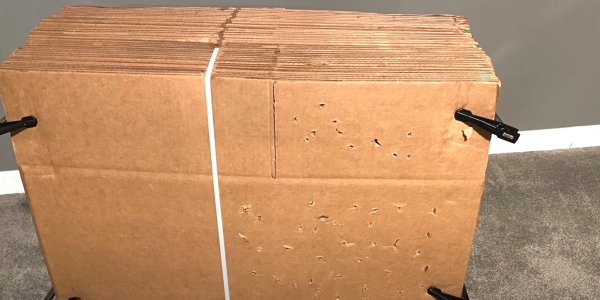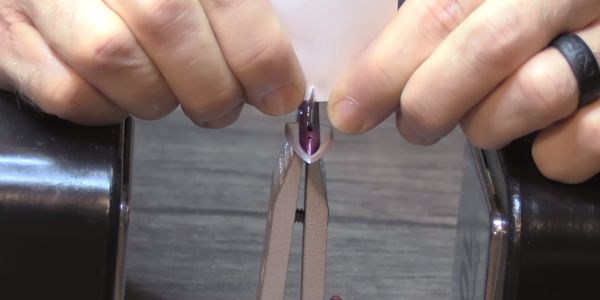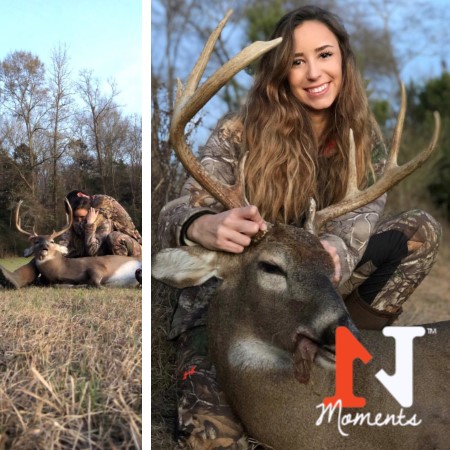In this review I tested the the Ozcut Elite Series 3 Blade. It’s a really cool head and I was eager to see how it performed.
But first, the box!
First of all, I’d be remiss if I didn’t show you how cool the box is for the Elite Series 3-blade broadhead… Ozcut really went all out!

The Ozcut Elite Series 3-Blace box has a 3D hologram on the front between the elk and the target.

When you open to box, it has lights behind the broadheads that illuminate them in gold and red. Very cool!
Now, a closer look at the Ozcut Elite Series 3-Blade Broadheads
Below is a look at the Ozcut Elite Series 3 head. As you will see, the overall length of the Elite Series 3-blade is much shorter than most of its competitors.

Here, we get a good look at the head close up. Of course, it spins very well. This is 125-grain model. It has got a 1 1/8-inch cut. The blades by my measurement are 0.52 inches thick. This picture was taken AFTER I had already shot it through a steel plate 5 times! So, you can see where the durability test results might be heading!

If you look at the VPA 3-blade broadhead (top), compared to the Ozcut Elite Series 3-blade head (bottom) you can see the length difference.

If you look at the Cutthroat 3-Blade (top) compared to the Ozcut Elite Series 3-blade (bottom), you can see the length comparison. The Elite Series is simply one of the shorter single-piece 3-blade heads that I’ve ever seen. That’s going to make it extra durable as well as aiding in flight, because there’s less surface area to it.
Sharpening
Now, this being a 3 blade like this, it can easily be sharpened on any flat edge.
However, because they have this extra tanto tip, there’s a bit of a different angle. The bevel angle on the tip is still 60 degrees, but it’s at different angle than the long edges of the blades, so it doesn’t lay flat.
If you were to lay it flat to sharpen it, the tanto tip would not get sharpened. So, you have to angle the broadhead just a little bit extra in order to sharpen that.

The tanto tip of the Elite Series 3.
You can sharpen it on any flat stone, or as I’ve noted in a recent test that I did of the Annihilator, you can also use the Stay Sharp Guide 344 sharpener, which changes the bevel from 60 degrees to 44 degrees (still very stout and strong, but much sharper.)
So, I’m going to sharpen this head up at the end of the review using the Stay Sharp Guide just see how sharp I can get it.
But overall, I love the design of this head, as well as the simplicity. It looked like it was going to be durable and fly well. So, I was eager to put it to the test.
I will cover some details on the tests I performed, but you can click the links to jump straight to the test results:
- Flight test results
- Penetration test #1 results
- Penetration test #2 results
- Sharpness testing results
- Edge retention test results
- Durability test results
- Re-sharpening results
- Cinder Block test results
The tests I performed on the Ozcut Elite Series 3-blade heads
I want to explain a bit about my tests on this head.
I do these tests to try to make them as relevant to hunting situations as possible, but I want to provide you with data points as well.
You can determine whether those data points are important to you or not, but I’m going to give you those to gauge or judge a broadhead’s effectiveness. Then, you can make the best broadhead selection for you and your hunting setup and your hunting situation.
Flight Test
I did a flight test where I shot two broadheads and a field point at 40 yards, just see relatively how well they group together and then I score them accordingly.
-

N-Tune™ Arrow Shaft Cleaning Cloths
$4.99 Add to cart -

N1 Outdoors® N-Tune™ Nock Tuning Reflective Arrow Wraps – Stain The Vanes™
Price range: $18.99 through $27.99 Select options This product has multiple variants. The options may be chosen on the product page -

N1 Outdoors® N-Tune™ Nock Tuning Reflective Arrow Wraps – Grip-N-R.I.P.™
Price range: $18.99 through $27.99 Select options This product has multiple variants. The options may be chosen on the product page
Penetration Testing
I did two penetration tests. In penetration test #1, I shot them through a half inch layer of MDF surrounded by two 1/3-inch layers of rubber foam mat and backed up by Clear Ballistics FBI Grade Gel.
In penetration test #2, I shot it into layered cardboard just to see straight up how many layers of cardboard the broadhead could penetrate through.

Here is the layered cardboard that I used for penetration test #2.
Sharpness Test
I did a sharpness test where I used the Edge-On-Up Sharpness Tester.
This tester has a small little clip that’s made out of aluminum with copolymer wire that’s engineered to be super consistent and to break in a certain way, rather than to stretch just to test edge sharpness.
This test measured the amount of grams of force it took to cut through that copolymer wire.
Edge Retention Test
Then I also did an edge retention test where after penetration test #1, I also did a sharpness test to see how much of the sharpness has been lost.
Durability Test (Steel Plate)
Then I did a durability test where I shot the fixed blade head through 22-gauge steel plate up to five times (When I test mechanicals, I only shoot through a half inch layer of MDF because they’re not quite as durable typically. And I shoot them five times through that layer of MDF just to see how well they hold up through that.)
Cinder Block Test
Finally, I shot the heads into a cinder block, just to see how a zero penetration exercise like this tests the overall structural integrity and durability of the head (plus, it’s just fun!)
Scoring
Once I finished all the tests, I took all of those scores and, based on how I think the broadhead performed, gave it a “Lusk Grade”, a score of 1 to 10 golden arrows, based on how effective that broadhead was at accomplishing what it set out to accomplish.
For all of these tests, I used my Bowtech SR6 27-inch draw, at 72 pounds. I lowered it to 65 pounds for the penetration test through cardboard, just because I didn’t want to shoot it all the way through and go into my wall! Then for most of the tests, I used the Bishop Archery FOC King Arrow. It’s super straight, flies extremely well, and is very durable. (For the harder impact tests, I’m used the Bishop Archery Firearm Dispatch Eliminator (FAD). It’s footed, so it’s extra durable.
Ozcut Elite Series 3 Test Results
So, now that I’ve explained a bit of the testing that I did, let’s get to the test results!
Flight Test Results
Below you can see the results of the flight test.

Here’s the Ozcut Elite 3 from the flight test. That one on the far right was the first shot (field point) and I pulled that shot, but I figured I’d just go ahead and finish shooting because I knew that was my error. The other two (broadheads) grouped extremely well.
Sharpness Test
I tested the Ozcut Elite Series 3 on the Edge on Up Sharpness Tester…

It took 400 grams of force to break the wire using the Ozcut Elite Series 3.
Penetration Test #1 – Ballistic Gel Results
You can see the results of shooting the Ozcut Elite Series 3 into the ballistic gel, fronted by foam matting and 1/2″ MDF.

The Elite Series 3 penetrated 7-1/2 inches into the ballistic gel.
Edge Retention Test Results
After penetration test #1, I tested the sharpness of the Elite Series 3 on the Edge On Up Sharpness Tester. It took 450 grams of force to break the wire.
Penetration Test #2 – Layered Cardboard results
Here, you can see the results of shooting into the layered cardboard.

Here, you can see it penetrated through 65 layers of the cardboard.
Durability Test Results
I shot the head through the steel plate five times. See below…

Here’s the head after going through the steel plate five times. It’s in excellent shape. There’s a slight nick in the edge right near the tip of one the blades. That would be very easy to file out. It held together extremely well and spins very well also.
Re-Sharpening
OK. I took one of these dull heads and spent a little bit of time sharpening it with the Stay Sharp Guide 344 just to see how it would do. I didn’t spend much time on it, but let’s see how it did…

Man, the Stay Sharp Guides really work well! It only took 275 grains of force to break wire… better than new!
Cinder Block Test Results
This test is always one of my favorites. Look what happened below when I shot the Elite Series 3 into the cinder block…

This head absolutely buried in the concrete. Man, this is the deepest I’ve ever had a broadhead go I think and it’s definitely the most stuck. I’m going to have to get out my chisel and hammer and work to get this thing out.

Here’s the head after I finally got it out of the concrete (I had to use a chisel and a hammer… It took about 20 minutes to get it out!) But man, it did very well. Still spun super well. You can see that the white part there is mostly just the concrete. The tip is still in perfect condition and very sharp. That Tanto tip is impressive. One blade got some nicks in it here. I don’t even know if you can make that out. But this head could definitely be resharpened even after being shot into the concrete.
Final thoughts on Ozcut Elite Series 3 Broadheads
So what do you think of the Ozcut Elite Series 3-blade?
I ahve to say, it performed really well. You can check out the score sheet and see the summary of all the different tests that I did below. But, this is a head really worth considering, especially if you are looking to maximize penetration.
For whitetails and so forth, I tend to prefer a head with a bit more cutting area than this with a 1-1/8-inch cutting diameter, though it will certainly get the job done.
It makes really nice holes so it will do it. I personally like something with a little bit wider cut. However, for bigger animals where you’re really going after deep penetration, this is something really worth considering.
Great job, Ozcut!





















































